Serendip is an independent site partnering with faculty at multiple colleges and universities around the world. Happy exploring!
"Stuff and Nonsense!"

Nonsense. It is the absence of logic, the disappearance of understanding. If something completely baffles our comprehension of the universe, we cry foul of its validity. It can be frustrating. It rubs against our conventional approaches to life. At the same time, nonsense is a challenge. It forces us to encompass a different mindset, to shift our perspective past the familiar in order to illustrate a concept that is impossible to see otherwise. Nonsense is a tool that can aid us in discerning our reality.
In the original Lewis Carroll Alice's Adventures in Wonderland and Through the Looking Glass and What Alice Found There, nonsense is used to illustrate the absurdities of civilized life. Subsequent variations on Carroll's Alice expand upon the theme of nonsense, playing with our notion of what is logical and sensible. "Phoebe in Wonderland" uses nonsense like Lewis Carroll's Alice. Yet the movie turns nonsense into a method of communicating Phoebe's struggles with her emerging Gilles de la Tourette syndrome. The transformation (and in some cases, direct translation) of this motif through different versions of the same story stretches Carroll's original nonsenses to parody different aspects of life that the books did not achieve. Despite its definition, nonsense in different Alice renditions is a tool of exploring the limits of understanding our reality.
Situations in Lewis Carroll's Alice books can resemble that of a Sally Cruikshank cartoon. However, nonsense is not always constant within the Alice books (Alice or another character tends to point it out when it does), but when it occurs, Carroll's nonsense is not nonsense in that it is an absence of meaning. Rather, it is meant to highlight certain ideas.
Wai Chee Dimmock brought up in class the idea that to prove something is true, the contrary must first be disproven. In the context of nonsense; to show that something is logical, the opposite must be shown to be illogical. Carroll confuses this notion primarily through his word and logic play, illustrating the subjectivity of both truth and reality. Think of Alice's exchange concerning the mouse's tale at towards the beginning of Alice's Adventures in Wonderland (p.37). Alice fails to distinguish between the mouse's tale that it attempts to tell and the mouse's tail which Alice can visually see. She ends up compounding the two into a strange structure in which the words of the tale twist in the shape of a tail. This, of course, is nonsense. We have never before experienced a tail that is a tale (or vice versa) and we can be fairly certain that we will not experience it again in the near future. But which is the truer meaning of the word? As readers we expect that the mouse is talking about a tail. We apply our Earthly logic to the situation: Alice had just asked the mouse to tell her its history concerning cats and dogs, so the tale that follows is most certainly the oral one. We use our abilities as readers to connect the word "history" and "tale" without confusing "mouse" and "tail". Yet Alice is looking directly at mouse. As soon as a "tale" is mentioned, she associates her visual information (and what anyone who thinks of a mouse might dwell on when tails are the subject) of the mouse and changes the meaning of what was said. Again, Alice fails to comprehend the mouse's intentional meaning in the following dialog (p.38):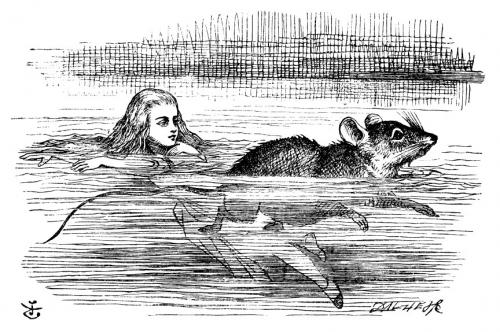

"I had not!" cried the Mouse, sharply and very angrily.
"A knot!" said Alice, always ready to make herself useful, and looking anxiously
about her.
"Oh, do let me help undo it!"
"I shall do nothing of the sort," said the Mouse, getting up and walking away.
"You insult me by talking such nonsense!"
Ironically, the mouse is drawing attention to the nonsense in this situation, begging the questions: What is really nonsensical? That a little girl misunderstood the contextual meaning of certain homophones? Or that an anthropomorphic talking mouse is telling her to stop being nonsensical?
The question of word meaning is addressed in the nonsense that Alice encounters in Looking-Glass Land when she meets Humpty Dumpty. After a multitude of twists in their conversation game, Humpty Dumpty begins using words to mean things they would not normally, even in the context of Looking-Glass Land. When Alice presses him for his reasons behind his peculiar diction, Humpty Dumpty replies, (p.188):
"When I use a word," Humpty Dumpty said, in rather a scornful tone,
"it means just what I choose it to mean-neither more nor less."
"The question is," said Alice, "whether you can make words mean so many different things."
"The question is," said Humpty Dumpty, "which is to be master-that's all."
To Alice (and to us), the idea that words can mean whatsoever the user chooses them to mean is contrary to what one is taught throughout a traditional education. Why should Alice reject Humpty Dumpty's authority to make up meanings whenever he desires? There is an established, official rulebook on the definitions of words (at least those that have been agreed upon to be recognized as words). To think that anyone can assign new and multiple meanings to words is illogical because we have the conception that she is unauthorized to do so. But who is authorized to write the dictionary? Oxford? Who is the (wo)man (or men or women or people) behind the curtain? Definitions of words are not entities in which we can rely on not to change. Many words completely transform from the original meaning into something entirely different. Here the nonsense of making a word be whatever one chooses lies within the notion that Alice and the reader believe language and grammar are fixed systems.
Alice, like the reader, must draw herself away from her "normal" Victorian expectations and learn to accept the absurd as the new norm (p.25):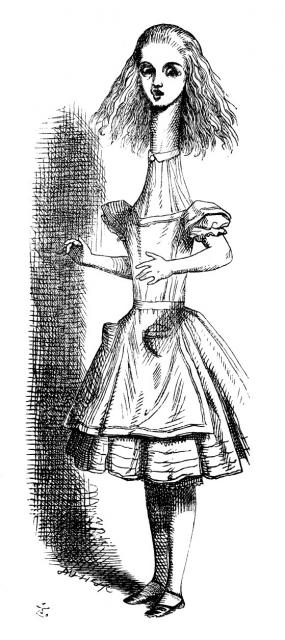

"She ate a little bit, and said anxiously to herself "Which way? Which way?" holding her hand on the top of her head to feel which way it was growing, and she was quite surprised to find that she remained the same size: to be sure, this is what generally happens when one eats cake; but Alice had got so much out-of-the-way things to happen, that it seemed quite dull and stupid for life to go on in the common way."
How easily Alice changes her assumptions on how the world works points towards how fluid our reality is. It seems logical that Alice should expect to change size after eating something in this new place because of her previous experience with shrinking after drinking. We draw our assumptions about reality from experience (something we discussed somewhat in class). Alice's expectation to grow is a sound, logical one, but it is absurd to us because on Earth (as apposed to Wonderland or Looking-Glass Land), we do not experience immediate size change from consumption and thus do not expect it. Alice, however, is in Wonderland. We can slowly begin to believe in Wonderland because of certain similarities and underlying structures we think we perceive. In Wonderland, one appears to gain knowledge of its workings through the same way that we do on Earth: experience. But we cannot fully accept it, and we call it nonsense, because we cannot apply most of our Earthly experience to Wonderland and Looking-Glass Land.
"Phoebe in Wonderland" uses nonsensical situations as a method of emphasizing the absurdities of normal life as well as a method for understanding Phoebe's conflict between the rules of societal norms and the rules that Tourette's syndrome imposes upon her behavior.
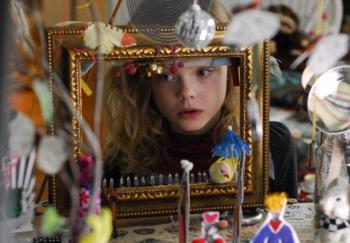
At the beginning of the movie, a sequence of scenes is shown featuring Phoebe listening to her grade school teachers recite the same rules as she starts each grade. "Questions will not be asked unless it is time to ask questions." When Phoebe raises her hand to ask about this rule, she is scolded for asking a question at the inappropriate time. The irony of not being able to ask a question about the rule on asking questions is not lost on Phoebe. The sequence heavily implies that the only reason for rules in the school environment is to reinforce the teachers' power over the children. Often, Phoebe is punished in the classroom for retaliating (partially due to Tourette's) against the other children's abuse. Her behavior is condoned while the other children's are ignored. The movie is parodying our understanding that a school has rules for maintaining a fair and orderly classroom environment to enhance learning. It highlights how restrictive these rules are to learning and how unfair and disordered the teacher chooses to use them. Phoebe is an example on the unreasonableness that societal rules can have.
On the other hand, Phoebe is an example of the unreasonableness her Tourette's rule are. When we begin to grasp that Phoebe is experiencing a set of rules invisible to everyone else, we begin to understand that what appears as nonsensical and confusing behavior to those around Phoebe is only nonsensical because they cannot perceive the underlying restrictions that make the behavior sensible to Phoebe. When Phoebe spits after being tagged, jumps a certain number of stairs, or repeats phrases, she is following her Tourette's syndrome's rules. In this way, Phoebe is like Alice is to the inhabitants of Wonderland and Looking-Glass Land. She is an outsider trying to learn the rules of the land, but time after time failing and falling back to her rules. Scenes in which Phoebe insults a large woman and then her best friend by exclaiming explicit remarks inadvertently are reminiscent of the scene in which Alice insults the birds and mouse of the caucus race by telling them about how her cat loves to eat creatures like them (p.38-39). It is illogical to one that Phoebe or Alice would continue to act in such a way when it is clear they are insulting their companions. They cannot help but continue such behavior, contradicting our ideas of how little girls should behave. Through these superficially reasonless behaviors of Phoebe, one obtains a deeper understanding of the difficulties in dealing with Tourette's syndrome.
Nonsense in Lewis Carroll's Alice's Adventures in Wonderland and Through the Looking Glass serves to parody life and our beliefs in how it works. "Phoebe in Wonderland" uses nonsense as a lens to parody aspects of modern life as well as to appreciate the challenge of a mentally disabled life. For us, recognizing nonsense is an important part in our construction of our reality. Understanding what something is not alternatively adds to the understanding of what something is. It allows one to question the solidity of our definitions of things,of ourselves, and of the reliability of experience as a foundation of the sensible.
As the Duchess might say,
"The moral is: nonsense tells us more about ourselves than sense ever could."
*"No no!" said the Queen. "Sentence first-verdict afterwards."
"Stuff and nonsense!" said Alice loudly. "The idea of having the sentence first!" (p.115)
Bibliography
Carroll, Lewis. Alice's Adventures in Wonderland and Through the Looking-Glass. New York: Signet Classic Printing, 1960. Print.
Matthews, Charles. "Satire in the Alice Books". Nineteenth-Century Literature Criticism. 53 (1996): 105-119. Web. 21 March 2010.
Phoebe in Wonderland. Dir. Daniel Barnz. Silverwood Films, 2008. Film.

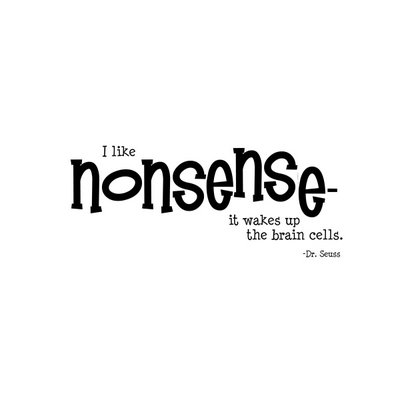
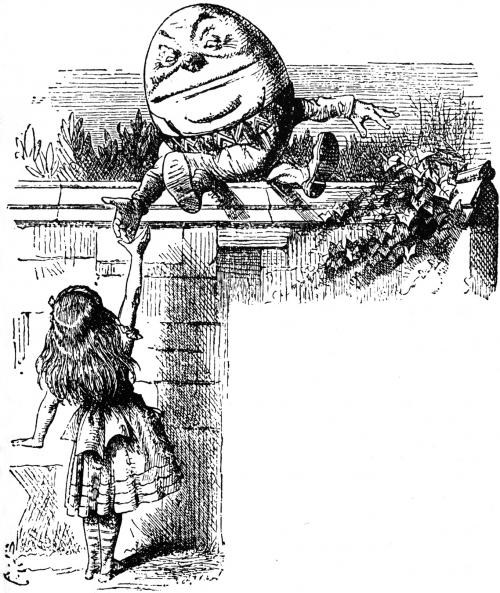
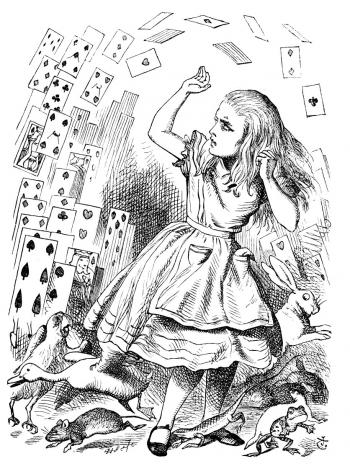


Comments
The Binary Beginning
I think we can and have created cultures in which something is not exclusively simplified to be defined as what it is and what it is not. However, I would argue that seeing things in a "black or white?" "either or" mindset is a beginning for thought. It answers the question of "what is this?" with "what is this not?". The most valuable thing about this method is that it leads us to the more challenging and difficult questions, the grey areas if you will.
In first world and most second world countries, we are no longer looking at which food is edible and which is not. We have transformed food into multiple cultures in which we ask about aesthetics, taste, and nutrition. We have identity crises. Like Alice, it is no longer a difference between you and I, but between what I was, what I am, and what I will be.Yet, we are still asking ourselves questions in the binary sense. For instance, what counts as alive and what does not. In these cases, our definitions most certainly entail negating something so as to distinguish it. What is the point of names or definitions if not to distinguish and/or describe something (or someone) to establish it as a separate entity from something (or someone) else (as Humpty Dumpty briefly discusses with Alice)?
Against negation
ShaynaS--
I'm thinking of a number of connections between your last paper, about challenges to copyright restrictions, and this one, challenging (among other things) the restrictions of the schoolroom, including the presumption that language and grammar are fixed systems, in a world where such things are really quite fluid. Several of your classmates wrote on this topic; you might find sgb90's Wonderland and the Parody of Meaning, as well as rmeyers's Defining Dreams to be of particular interest: both like and different from your own explorations.
Where your paper gets particularly interesting, I think, is when you suggest that Phoebe, who breaks the rules of the orderly world because she has Tourette Syndrome, is "experiencing a set of rules invisible to everyone else." As she repeatedly says, she can't help/stop or control her behavior. One set of rules -- social conventions -- is thus broken by another: and where from the latter? What is the source of the rules she follows despite her "self"?
I suggested to spleenfiend, who also wrote about the adaptation that is Phoebe in Wonderland, that she might be interested in a wonderful essay called called Culture as Disability, as well as the various commentaries on it on Serendip, such as The Inevitability of Cultural Disabilities and Cultures of Ability (which imagines the construction of cultures that disable no one). You might be also.
Thinking about these essays in light of your essay, I'm wondering if we can create cultures not based on the binary of the not-cultured, and go even further, metaphysically, to challenge your notion that "understanding what something is not adds to the understanding of what something is." Could we reach understanding by some route that doesn't entail negation?